First run through
“Standby Studio!”
The floor manager and assistant floor manager(s) have made sure that all the cast are ready for the first run through. This is going to start at 14:15. All the cast are in costume, but not everyone has yet had full make-up; The principal players are ready – it is the supporting actors and character actors who still need make up.
The TM2 has warned telecine using the internal telephone line of the likely start time for the run through, and in any case, they can hear studio talk-back: they need this in order to start on cue. The TM2 talks to telecine over the phone lines to assure himself that all is fine, and that the telecine operators know all the inserts that they are expected to make. In this episode, the only inserts are the opening titles and a short sequence showing the suspects getting into a van and driving off. The shots of the van interior are being done in the studio – live – with the van in front of a back-projection screen.
The TM2 asks telecine if they have spliced the filmed vehicle insert onto the end of the title sequence. The response from telecine is that, no, they would prefer to load the film of the vehicle separately from the title sequence. This film insert has been supplied as a negative, tail out, and so has to be wound onto a telecine feed spool before loading into the telecine machine. 35mm film is packaged as 1k, 2k, or 3k spools and running at 98 feet per minute, giving 10, 20 or 30 minutes running time. 16mm film inserts are supplied to telecine on 30 or 60 minute spools (however short the insert).
There is plenty enough time to reload telecine and set up on the “10” leader, as the vehicle insert is not needed until 27 minutes into the show – just over the hallway point. The “10” on the leader is taken from standard cinematography practice, which gave a 10 second run-up to the first frame of the film. The telecine machines are much faster, so a “10” in the gate usually means an eight and a half second run-up time
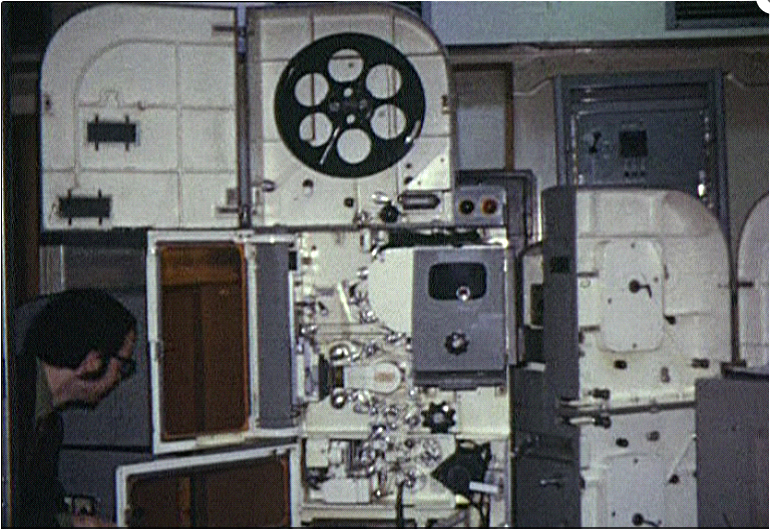
14:15 and the director calls out “Run TK!” The run-through has started.
Cameras 3 and 2 have a caption each at the end of the TK inset.
Cameras 1, 4 and 5 are on the opening scene, outside the pub. This is the first time that the scene has been played at full speed, and the actors are visibly getting into the part – there is more “acting” than there was in the Stagger Through. The majority of actors at this time – with live television – know that it is important to maintain consistency of performance through all the rehearsals, but all technical and production staff know as well that performances are likely to be sharper, perhaps louder, more positive on the live performance and are aware that they might have to be prepared to shift position slightly to frame up the picture correctly. Camera 5 has it a little easier in this respect, as with the zoom lens on the front, slight changes in the actor’s (actress’s) position could be compensated by a judicious zoom in or zoom out. This is particularly useful and important in one scene that camera 5 has, where an older woman – Davey’s mother – lets rip when she finds out what her son Davey is up to: cheating on a woman and, in the process, stealing a hundred grand.
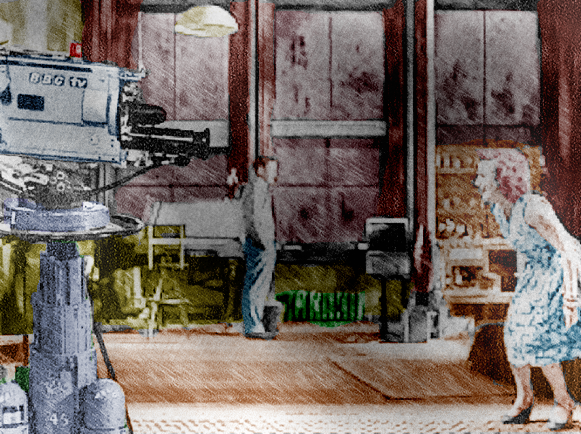
“More to the right, camera 2, for that two shot.” There is still the opportunity for some adjustments to a shot while the rehearsal is in progress, and camera 2 needs to make a note of this as he goes along. However, most notes will wait until the end of the run-through.
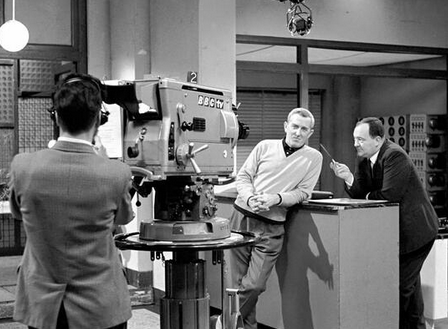
The rehearsal seems to be going relatively smoothly, when suddenly there is a flurry of waving arms. Camera 4 is trying to get the attention of at least one of the cable-bashers who are standing around, and some cameramen are trying to relay these signals. The cable -bashers run to camera 4, who is trying to get under camera 1’s cable. With a scrabble and a stretch, the cable –bashers pulling out a length of camera 1’s cable into the studio, camera 4 cameraman ducks under the lifted cable and pushes the ped with all speed to position 4B. He is in the process of craning up the ped to the required height when the cue light goes on. The shot is out of focus and incorrectly framed. “Is there a problem, camera 4” asks the TM2. Camera 4 cameraman pans the camera from side to side – a “shaking the head” movement, meaning “no”. Once the cue light is off. Camera 4 gets quickly into the right position, and the scene continues to run.
On to the next scene – in the police station outer office. “And cue!”
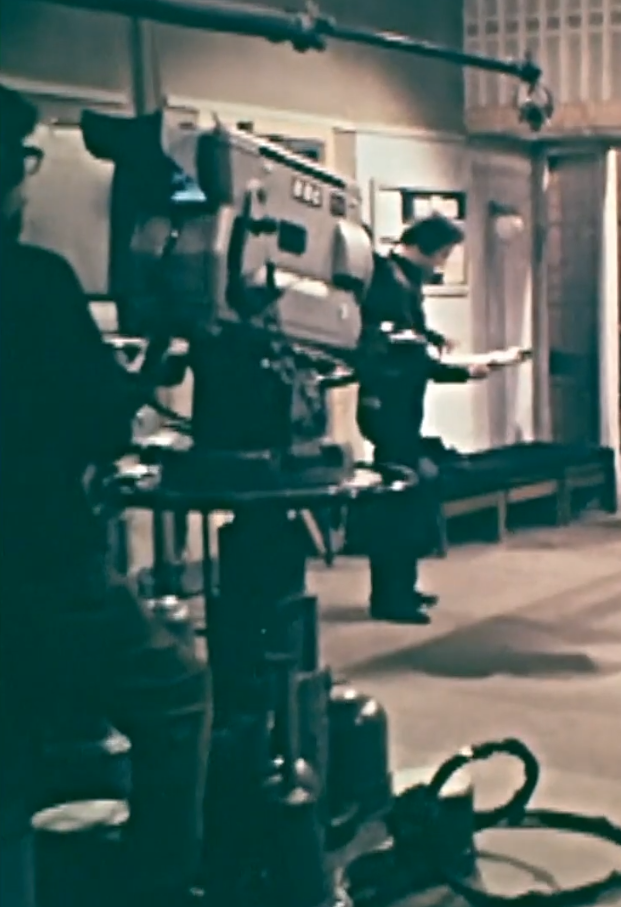
This run through is the first chance that the Vision Mixer has had to cut and mix between the cameras at speed: through the Stagger-Through he has been able to follow the script and the direction in a sort of slow motion, but now he has to cut and mix around about 500 shots or so in the fifty minutes. (Today the vision mixer is a “he”, although many of the vision mixers are women – sometimes during the stagger-through you can discern the click-clack of knitting needles along with the click -clack of the vision mixing desk buttons being pressed.)
The vision mixing desk is made up of two banks of faders – designated the “A” and “B” bank – and each bank has 8 faders. Any source can appear on any of the faders, although normally cameras 1 to 4 occupy the first four fader positions on each bank cameras 1 to 6 on the first six positions for today’s programme). There are two faders with associated cut buttons to crossfade or cut between the two banks. There are two main ways of using the desk. One way is to mix primarily on the “A” bank, selecting each camera on that bank as needed (or cross-fading between cameras on that bank). The other way (similar to the practice used in the earlier days of television) is to select a camera on the “A” bank, and then select the next camera on the “B” bank: at the time of the cut between the cameras, the Vision Mixer switches between the “A” and “B” banks. In the following picture the two banks can clearly be seen. This second method allowed the next camera shot to be seen on a “preview” monitor – typically the top right monitor.
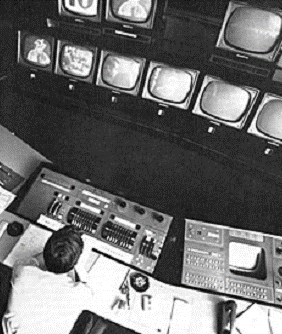
It is sometimes disconcerting to hear a double click for each shot, as a camera is selected for preview and the banks are later switched over (this could cause problems on fast shot change sequences where you listened for the “click” to change lens or move position rather than watching the cue light). In any case, the “preview” monitor on a live “Softly, Softly” is switched to “network” (broadcast transmission) so that the production staff could see the cue dots from Presentation and then the TM2 could check that the network was broadcasting what was being transmitted from the studio.
Other sources besides the cameras have to appear on the vision mixing desk – telecine and the inlay desk output. (On some shows there could be two telecine channels, two VT channels and the Inlay desk to accommodate on the two banks. The vision mixer needed to chat with Racks to get the channels appearing where he or she wanted them, if there was a specific requirement.)
During this run-through, the TM1 is busy checking that the lights are doing their job – lighting the subjects! The Vision Control Operator sets all the camera controls – iris, black-level and gamma – in the middle of their ranges, and the TM1 or Vision Supervisor looks at the picture from each camera on a scene to check that the pictures are matching as near as possible. He might have to check the light output from specific luminaires by adjusting the dimmer on the lighting console. Each luminaire is patched into the lighting console, and whole banks of lights can be controlled by a “master” dimmer. Different combinations of lights are needed to represent the “daytime” scenes and the “night-time” scenes, and the lighting dimming panel allows for fast changes between these.
The TM1 or Vision Supervisor also needs to note when the lighting does not produce enough light for the cameras to work effectively, and he also checks there is sufficient variation in tones across each shot in the scene and that each actor is well modelled by the lighting. Some adjustments may be needed after the run through to improve the lighting.
Getting a well-lit production with no boom shadows or other unfortunate shadows, with good facial modelling of the actors, and which also helps set the mood or “atmosphere” is as much an art as a science. The TM1’s job today is somewhat easier, as there are a number of sets which are the same for each episode and so the lighting rig for these is well-known.
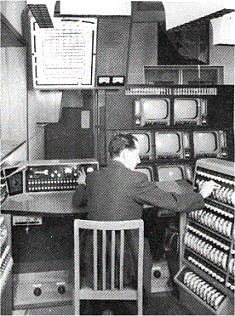
The white diagram on the wall shows the Vision Supervisor (VS) (and/or the TM1) which lights in the studio are currently lit – a set of small bulbs are directly fed from the dimmers, and mimic the brightness set for that particular light. (The Vision Supervisor (VS) usually operated the console while TM1 watched on his main monitor.)
Just before notes, the cameraman on camera 4 and the cable-bashers have a quick conference. They discuss the issue of getting camera 4 into position when going under camera 1’s cable.
“We could reroute your cable”, suggests one of the cable-bashers. “Connect your camera to a wall point close to camera 1’s and then you won’t have to go under its cable.”
“Yes, but then there is camera 1’s track down the street scene,” says one of the other cable-bashers. “There would have to be a long loop of 4’s cable in front of camera 1, and it might well get in shot.”
That was the clincher, really. There would not be enough time to pull out the length of camera 4’s cable needed for camera 1’s track – and there might not even be enough length of cable given where camera 4 had to be next. So the only answer is for camera 4 to go under camera 1’s cable – and quickly!
Notes at the end of the First Run Through
It was no surprise that the first item on Notes at the end of the run-through was the move of camera 4.
“Are you going to be able to get there?” asks the director over talk back.
Camera 4 pans the camera quickly up and down a couple of times – like nodding your head, meaning “yes”. The boom operator drops the mike near camera 4.
“It’ll be OK”, says camera 4 cameraman, “Just had not got it quite organised.”
”OK”. The director is satisfied – he trusts the crew – but there was no surprise that the two scenes either side of camera 4’s move are going to be run through once again, just to check.
However, the main concern is an overrun. The run-through has taken 50 minutes and 58 seconds – an overrun of nearly a minute. A very rough approximation is that one page of script takes a minute to deliver. A script for a fifty-minute programme has about fifty pages of dialogue – of course, there are variations because some scripts might have more stage directions or VT and TK inserts, and other scripts more dialogue per page, but it is a good rule-of-thumb. This episode of “Softly, Softly” had 52 pages of script – but it was also a fast-cutting programme, so it would have been expected to run to time.
But also at this time Presentation is starting to ask all programmes to run 30 seconds under the booked time, so that there would be time for trails: in fact, there was a memo to this effect in force. So a 58 second overrun was not acceptable.
The floor manager says that he will speak to the main cast members and try to get them to up the pace a little bit, and that that should take care of the overrun.
The other main note concerns the dog bark. “That’s an excellent dog bark”, says the director,” and it came on just on cue. But it sounds just a bit too fierce. Can you do something about that?”
The Sound Supervisor says that they would be able to do something about that.
The rest of the notes concern the performances of the various actors – an expression here, a turn of the head there, that sort of thing. No more technical issues.
The next three-quarters of an hour are taken up with re-rehearsing some of the scenes – the scenes involving camera 4’s move amongst them. As the cable-bashers are all aware of what is needed, there is absolutely no problem in getting camera 4 into position.
Meanwhile in the two galleries either side of the main production gallery there was some activity. In the lighting galley, the Vision Control Operator is beginning to tweak the camera iris and black-level controls. These had been untouched during the run, But the VCO is concerned that there were some shots where one of the cameras was showing a significantly darker picture that the others – the actors were not quite in the place where the TM1 had expected them to be, so the Key light was not lighting the face as expected. The TM1 had gone down to the floor, but there was little room for manoeuvre, either for the actor or for the light itself. Vision Control would have to compensate.
In the Sound Gallery, the Sound Supervisor is in discussion with the Gram Op about the dog bark. The Sound Supervisor wonders if there was a similar bark that could be used instead. The Gram Op counters with the statement that he had already been through all the dog noises, and this was the best bark for the purpose.
“Could we knock out some of the top frequencies?” asks the Gram OP. “That would make the dog bark sound less sharp,”
“And what? Make it sound like it was on a telephone line?” the Sound Supervisor counters.
“No, of course not” replies the Gram Op. “ But perhaps some equalisation can be used on the bark to change the general frequency response, tone it down a bit.”
Between them, the Gram Op and the Sound Supervisor adjust the sound of the bark so that it was less “sharp” in tone. Less attack on the leading edge of the waveform, a modification to the higher frequencies – without clipping – using equalisation. Finally they are happy with the result, which they play back to the director. He is very pleased with the result.

Four o’clock. Time for tea. Lock off the camera pan and tilt heads. All out to Red Assembly area for tea or coffee, cakes and snacks. The final run-through is next.
SECOND RUN THROUGH
The final run is scheduled for five o’clock (17:00). Between the end of tea break and the start of the run, the studio is quite a hive of activity.
For this run, everyone is in costume and full make-up – it is the same as the final dress rehearsal for a stage production. In fact, on some productions this might be called the dress run, but on “Softly, Softly” it was just the second run-through.
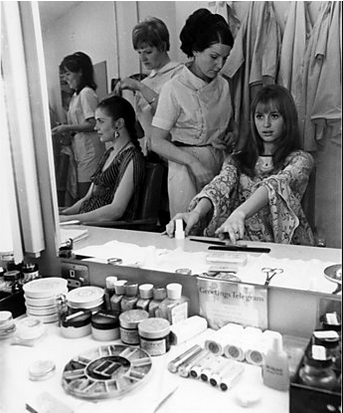
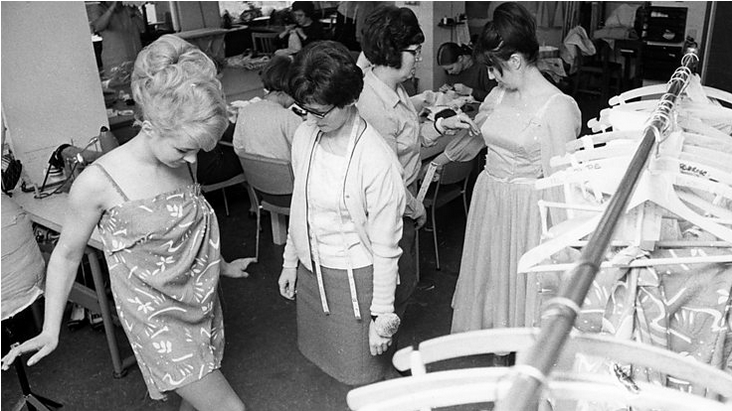
All the cameras and mic booms have to move back to their starting points from wherever they have been left at the start of the tea break. All the cables are cleared from the main areas: the camera cables looped in figures-of-eight at the side of the studio clear of the fire lanes, the mic boom cables coiled neatly on the studio floor.
The roller caption has to be rolled back to the start position.
The scene staff make sure that all the props are in position, and any last-minute set-dressing is taking place.
The actors come from their dressing rooms into their start positions. All are in costume and all are made up – this helps both the make-up girls to check that the make-up looks OK on screen, and helps Vision Control since all the shiny parts of the actor’s faces (their foreheads and noses) are powdered and so are less reflective of the lights: any such reflections affect the overall tonal quality and balance of the picture.
During this run, it is likely that the assistant floor manager (at least) takes charge of the prompt cut. This push button is at the end of a long cable, tied off on the lower yellow bar and connected to one of the wall points. When pushed, all sound from the studio is cut, the output from the Ferrograph tape recorder is switched into circuit to provide “studio atmosphere noise” and so the floor manager or assistant floor manager can shout the cue to the actor.
The Technical Manager 2 has been checking with telecine that they are ready: good to go.
All is ready.
Everyone is listening attentively to talkback.
The run starts when the director cues Telecine – TK: “Run TK!”
10, 9. 8. 7, 6, 5, 4, 3 on the telecine leader. Camera 3 is next, with a caption, then camera 2.
“Pacey pacey everyone, ” calls out the floor manager as he cues the actors in the pub doorway. The rehearsal is under way.
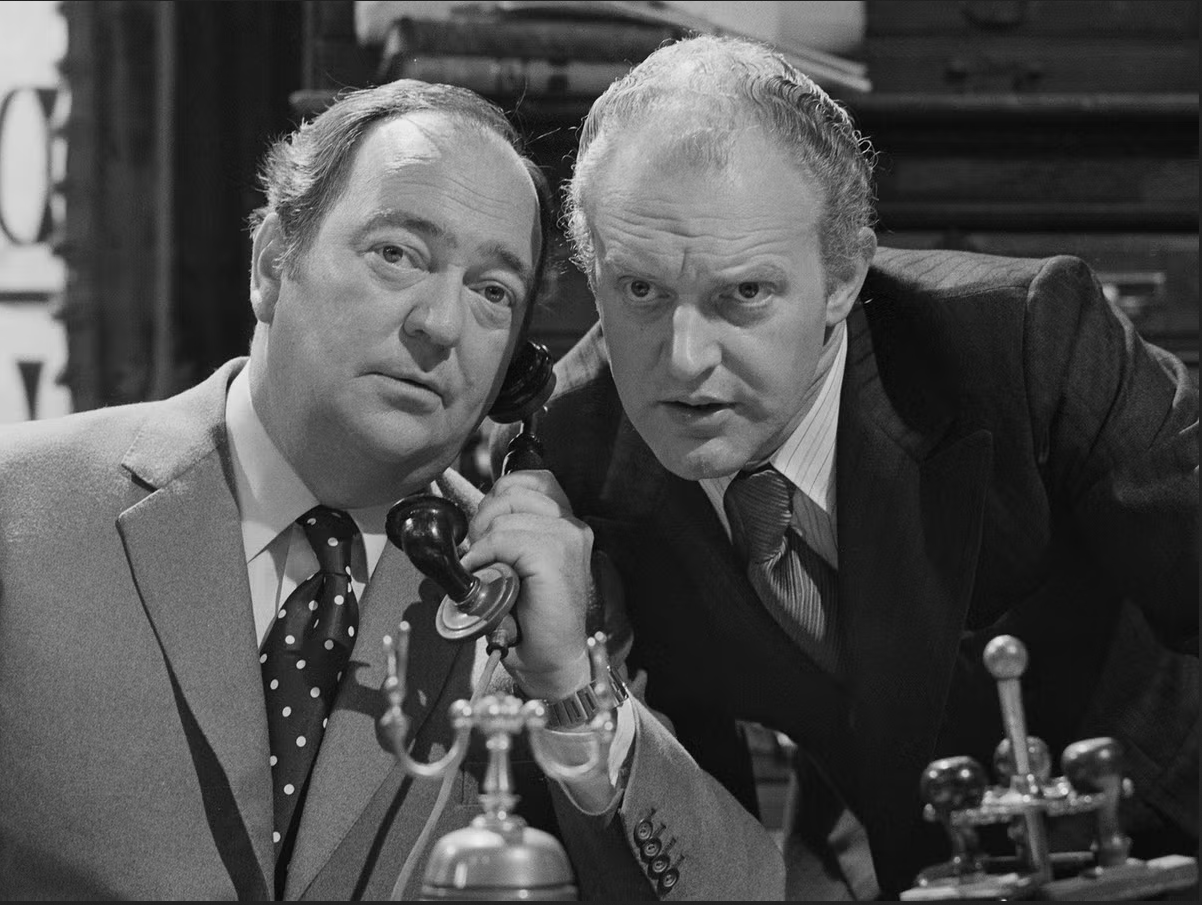
All the actors are tightening their performances – it is very interesting to see how, over the course of the rehearsals and transmission, Alan Stratford John’s performance as Charlie Barlow becomes grottier and grittier with each run, until at transmission he is the gruff, hard policeman that everyone knows.
,
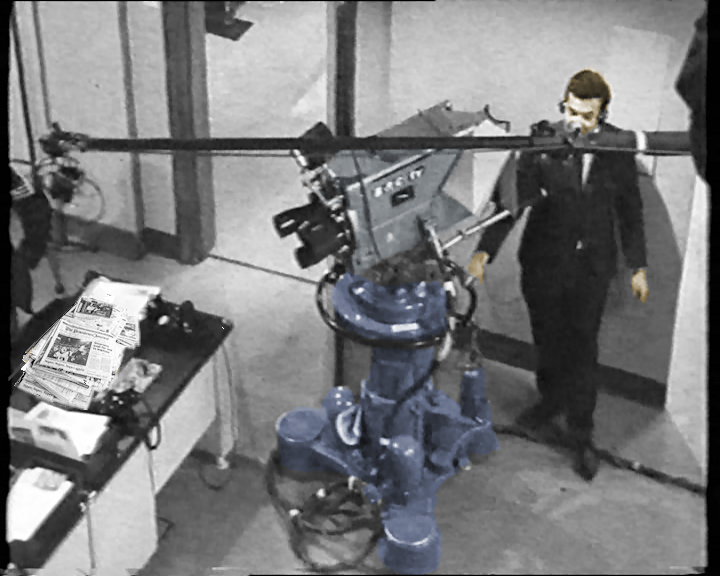
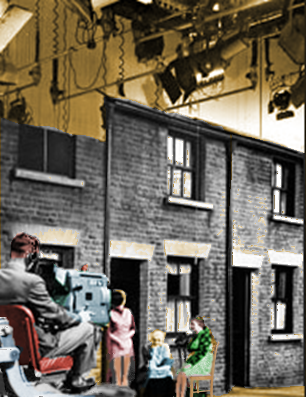
Extras make the scene look alive – set dressing really!
Camera 4 has no problem getting to his position with the help of the cable bashers – and there is of course no problem for camera 1’s tracking shot along the street of terraced houses. – brightly lit as this is daytime. This is a scene representing the outside in a street recreated in the television studio using studio camera and lighting.
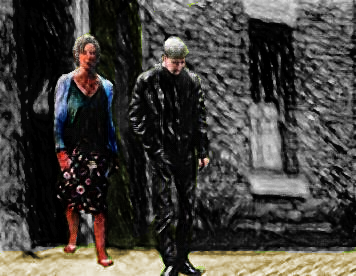
Artist’s Impression: Wide 2-shot Street scene at night
– stronger backlighting compared to keylight
Later in the program, the same set is lit as a night scene. There is stronger backlighting to “pull the actors away” from the background: the key lights are reduced so there is less sharp facial modelling. These changes are all pre-set on the lighting console.
Even for a night-time scene, the pictures must include a fair amount of AC content (variations between light and dark), otherwise the domestic receivers of the time won’t handle the pictures correctly (with certain low AC content pictures, the line output transformers in the receivers can start “screaming”: this is in addition to the whistle or hum created because of magnetostriction in the magnetic core and periodic movement of the windings of the domestic television’s frame flyback transformer).
Notes at the end of the Second Run Through
The main concern at the end of the run through is that the programme is still over-running by thirty seconds. The floor manager again says that he will speak to the actors and tell them that they need to go just that little bit faster. The issue is, of course, that the next run is the live transmission; everyone will up their game, of course, but the actors will be more concerned to deliver a good performance. Still, they are all professionals, and know that television programmes have to run to time. All the actors say that they understand and will try to speed up.
One thing that needs to be checked is the back projection and the van. The cast and crew set up the scene as it was for the run through. The cameraman for camera 2 meets with the director on the studio floor.
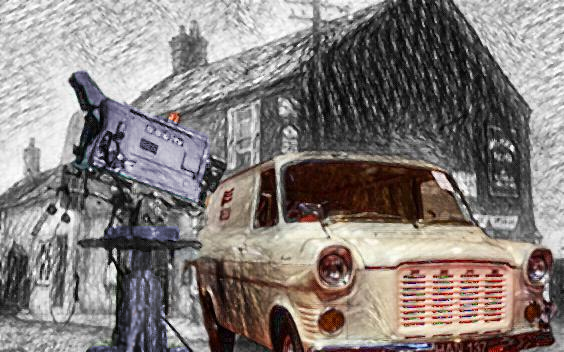
It’s mainly a problem with camera 3. The back projected picture looks too close to the van. The back projection is monochrome: since the programme is going out in black and white, there is no point in having a back projection in colour. The reason is that the back projection screen is very close to the van’s rear bumper. A full-size van is being used for this scene (and not a cut down vehicle as is sometimes used so that the cameras can get closer) because there is some action in the rear of the van – and viewed through the van windows. The back projection is not used to try to show the vehicle in motion: it is a static scene with pedestrians and vehicles passing the stationary van.
The solution is to defocus the back projection image. On the cameras, this makes the back scene look a bit further away. The projector for the back projection could be moved nearer to the mirror, which would reduce the throw of the projector and make the image smaller (and so look further away), but really the whole width of the screen is needed for camera 3’s shots so that the complete passenger side of the van can be seen without camera 3 shooting off the edge of the screen, As it is, it is a bit tight for camera 3 – although no one noticed, except camera 3 cameraman, camera 3 had actually shot off the side of the screen for the whole of the back projection scene during the first run.
Camera 4’s move from position 4B back to 4A under camera 1’s cable had gone well during the second run through, and it was just achievable in time, with co-operation from the cable bashers and from the boom trackers who had to make sure that their microphone and wrapped and taped talkback cables were in a suitable position and with sufficient slack so that camera 4’s pedestal and camera could push these cables away in front of the ped as the camera got into position: the cable guards on the ped were usually adequate for this job. (Absolutely NOT best practice, but it did sometimes happen, the pedestal and camera could “ride over” over single cables – that is, cables not twisted and taped together – in an emergency or extremely tight move (and the camera’s cable guards would have to have been raised up from their lowest position or they might well have cut through the individual mic and talkback cables). Not recommended on live transmission!). For camera 4, all looks well set up for transmission.
Six thirty, time for supper break. Over to the Television Centre canteen, pork pie, chips and beans. Collect up the sugar lumps. Back to the studio, sit in the production gallery until it is time for line up at seven thirty.
At eight o’clock (20:00) we will be going on air to an audience of some 18 million people….
 |  |  |



